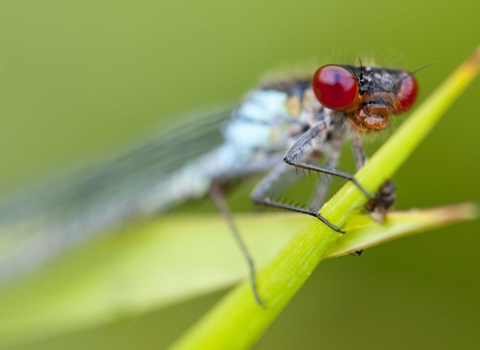
©Ross Hoddinott/2020VISION
Red-eyed damselfly
The Red-eyed damselfly is a small, but robust, damselfly of canals, ponds, lakes and slow-flowing rivers. As its name suggests, it has bright blood-red eyes, but a mostly black body.
Scientific name
Erythromma najasWhen to see
May to SeptemberSpecies information
About
The Red-eyed damselfly is a small, but robust, damselfly of canals and slow-flowing rivers, ponds and lakes where it can often be seen sitting on lily pads. It is on the wing from the end of May through to August. When the larvae of damselflies are ready to turn into adults, they emerge from the water and moult their larval skin, leaving behind a cast known as an 'exuviae' - look for these on emergent vegetation around the edges of waterbodies.How to identify
The Red-eyed damselfly is mostly black in colour, with a pale blue band at the end of the body, blue patches on the thorax, and bright, blood-red eyes. It is more robust than the similar Blue-tailed damselfly, which doesn't have red eyes. The Small Red-eyed damselfly is very similar, but a little smaller and more delicate, and has orangey-red eyes.Distribution
Found in Southern and Central England, spreading north and into Wales.In our area
The Red-eyed Damselfly is more or less restricted to the Montgomery Canal, with very few Montgomeryshire records outside of this corridor. It can be easily seen, when the adults are on the wing, even within the Welshpool town section; look on the lily pads!
Did you know?
The closely related Small Red-eyed damselfly (Erythromma viridulum) was first recorded in this country in 1999 and is now found throughout South East England and parts of the Midlands.The Red-eyed Damselfly is more or less restricted to the Montgomery Canal, with very few Montgomeryshire records outside of this corridor. It can be easily seen, when the adults are on the wing, even within the Welshpool town section; look on the lily pads!
